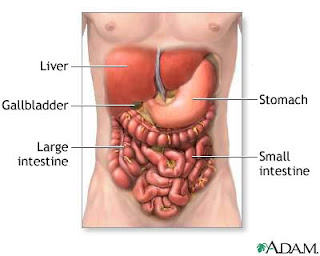Impossible in this fast paced society, but it's the most effective way to eliminate indigestion and it's free. As the food is chewed, it is moistened and mixed with saliva,
 which contains the enzyme ptyalin. Ptyalin changes some of the starches in the food to sugar.
which contains the enzyme ptyalin. Ptyalin changes some of the starches in the food to sugar.The digestive juice in the stomach is called gastric juice. It contains hydrochloric acid and the enzyme pepsin. This juice begins the digestion of protein foods such as meat, eggs, and milk. Starches, sugars, and fats are not digested by the gastric juice. After a meal, some food remains in the stomach for two to five hours. But liquids and small particles begin to empty almost immediately. Food that has been churned, partly digested, and changed to a thick liquid is called chyme. Chyme passes from the stomach into the small intestine.
I've observed people taking large pieces of meat, chewing 2-3 times and down it goes. Then bewildered about why they have indigestion. You'll be amazed the varied opinions you get when questioning people about digestion or indigestion. Some must feel that food just disappears, evaporates. Wishful thinking.
The following are some of the elements broken down in the digestion system:
Sugars are digested in one step. An enzyme in the lining of the small intestine digests sucrose, also known as table sugar, into glucose and fructose, which are absorbed through the intestine into the blood. Milk contains another type of sugar, lactose, which is changed into absorbable molecules by another enzyme in the intestinal lining.
Fiber is indigestible and moves through the digestive tract without being broken down by enzymes. Many foods contain both soluble and insoluble fiber. Soluble fiber dissolves easily in water and takes on a soft, gel-like texture in the intestines. Insoluble fiber, on the other hand, passes essentially unchanged through the intestines.
Protein. Foods such as meat, eggs, and beans consist of giant molecules of protein that must be digested by enzymes before they can be used to build and repair body tissues. An enzyme in the juice of the stomach starts the digestion of swallowed protein. Then in the small intestine, several enzymes from the pancreatic juice and the lining of the intestine complete the breakdown of huge protein molecules into small molecules called amino acids. These small molecules can be absorbed through the small intestine into the blood and then be carried to all parts of the body to build the walls and other parts of cells.
Fats. Fat molecules are a rich source of energy for the body. The first step in digestion of a fat such as butter is to dissolve it into the watery content of the intestine. The bile acids produced by the liver dissolve fat into tiny droplets and allow pancreatic and intestinal enzymes to break the large fat molecules into smaller ones. Some of these small molecules are fatty acids and cholesterol. The bile acids combine with the fatty acids and cholesterol and help these molecules move into the cells of the mucosa. In these cells the small molecules are formed back into large ones, most of which pass into vessels called lymphatics near the intestine. These small vessels carry the reformed fat to the veins of the chest, and the blood carries the fat to storage depots in different parts of the body.
Vitamins. Another vital part of food that is absorbed through the small intestine are vitamins. The two types of vitamins are classified by the fluid in which they can be dissolved: water-soluble vitamins (all the B vitamins and vitamin C) and fat-soluble vitamins (vitamins A, D, E, and K). Fat-soluble vitamins are stored in the liver and fatty tissue of the body, whereas water-soluble vitamins are not easily stored and excess amounts are flushed out in the urine.
Water and salt. Most of the material absorbed through the small intestine is water in which salt is dissolved. The salt and water come from the food and liquid you swallow and the juices secreted by the many digestive glands.
Through digestion you have a complete breakdown of food that has to Metabolise which involves a complex network of hormones and enzymes that not only convert food into fuel but also affect how efficiently you burn that fuel. A long discussion for another time.
Because of our habits indigestion is a far to common problem. Teas have had a calming affect in this area for ages. We provided a link to our TEA articles or go directly to Adagio Tea Co. for more information by clicking on the ads.
So you can save yourself a lot of headaches and heartburn if you just chew, eat slowly and enjoy food as nature intended. Curing indigestion could be as simple as changing your eating habits.
Enzymes and Digestion
These are the pac-man that breakdown food and with the diets we have today these enzymes are scarce.
There are different enzymes to breakdown different food compositions but, to simplify matters a good balanced formula is the place to start. In most cases you will get the benefits you are looking for.
If the balanced formula is working for you results will be quick, within a day or two. If digestion is still an issue you may have to do it the hard way.
Eat one food group at a sitting and see which food is not digesting properly. Once you identify the food that is not digesting fully you can supplement the enzyme needed for that food group. This is in addition to the balanced formula.
1 comment:
Very very useful information...
By just chewing food properly, we can get rid of so many health problems. We generally do not pay attention on this.
I have little bit indigestion problem. After I read your article, I will chew food properly and will see how it make difference...
Thanks
Post a Comment